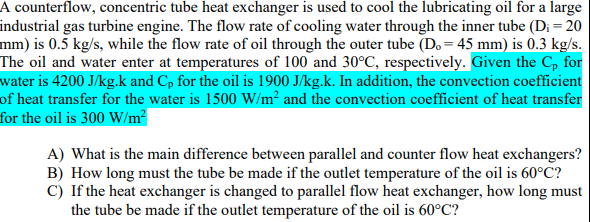A counterflow, concentric tube heat exchanger is used to cool the lubricating oil for a large industrial gas turbine engine. The flow rate of cooling water through the inner tube (D; = 20 mm) is 0.5 kg/s, while the flow rate of oil through the outer tube (Do = 45 mm) is 0.3 kg/s. The oil and water enter at temperatures of 100 and 30°C, respectively. Given the C, for water is 4200 J/kg.k and C, for the oil is 1900 J/kg.k. In addition, the convection coefficient of heat transfer for the water is 1500 W/m² and the convection coefficient of heat transfer for the oil is 300 W/m A) What is the main difference between parallel and counter flow heat exchangers? B) How long must the tube be made if the outlet temperature of the oil is 60°C?
A counterflow, concentric tube heat exchanger is used to cool the lubricating oil for a large industrial gas turbine engine. The flow rate of cooling water through the inner tube (D; = 20 mm) is 0.5 kg/s, while the flow rate of oil through the outer tube (Do = 45 mm) is 0.3 kg/s. The oil and water enter at temperatures of 100 and 30°C, respectively. Given the C, for water is 4200 J/kg.k and C, for the oil is 1900 J/kg.k. In addition, the convection coefficient of heat transfer for the water is 1500 W/m² and the convection coefficient of heat transfer for the oil is 300 W/m A) What is the main difference between parallel and counter flow heat exchangers? B) How long must the tube be made if the outlet temperature of the oil is 60°C?
Principles of Heat Transfer (Activate Learning with these NEW titles from Engineering!)
8th Edition
ISBN:9781305387102
Author:Kreith, Frank; Manglik, Raj M.
Publisher:Kreith, Frank; Manglik, Raj M.
Chapter10: Heat Exchangers
Section: Chapter Questions
Problem 10.32P
Related questions
Concept explainers
Heat Exchangers
Heat exchangers are the types of equipment that are primarily employed to transfer the thermal energy from one fluid to another, provided that one of the fluids should be at a higher thermal energy content than the other fluid.
Heat Exchanger
The heat exchanger is a combination of two words ''Heat'' and ''Exchanger''. It is a mechanical device that is used to exchange heat energy between two fluids.
Question

Transcribed Image Text:A counterflow, concentric tube heat exchanger is used to cool the lubricating oil for a large
industrial gas turbine engine. The flow rate of cooling water through the inner tube (Di = 20
mm) is 0.5 kg/s, while the flow rate of oil through the outer tube (Do = 45 mm) is 0.3 kg/s.
The oil and water enter at temperatures of 100 and 30°C, respectively. Given the C, for
water is 4200 J/kg.k and Cp for the oil is 1900 J/kg.k. In addition, the convection coefficient
of heat transfer for the water is 1500 W/m² and the convection coefficient of heat transfer
for the oil is 300 W/m?
A) What is the main difference between parallel and counter flow heat exchangers?
B) How long must the tube be made if the outlet temperature of the oil is 60°C?
C) If the heat exchanger is changed to parallel flow heat exchanger, how long must
the tube be made if the outlet temperature of the oil is 60°C?
Expert Solution
This question has been solved!
Explore an expertly crafted, step-by-step solution for a thorough understanding of key concepts.
This is a popular solution!
Trending now
This is a popular solution!
Step by step
Solved in 2 steps with 11 images

Knowledge Booster
Learn more about
Need a deep-dive on the concept behind this application? Look no further. Learn more about this topic, mechanical-engineering and related others by exploring similar questions and additional content below.Recommended textbooks for you

Principles of Heat Transfer (Activate Learning wi…
Mechanical Engineering
ISBN:
9781305387102
Author:
Kreith, Frank; Manglik, Raj M.
Publisher:
Cengage Learning

Refrigeration and Air Conditioning Technology (Mi…
Mechanical Engineering
ISBN:
9781305578296
Author:
John Tomczyk, Eugene Silberstein, Bill Whitman, Bill Johnson
Publisher:
Cengage Learning

Principles of Heat Transfer (Activate Learning wi…
Mechanical Engineering
ISBN:
9781305387102
Author:
Kreith, Frank; Manglik, Raj M.
Publisher:
Cengage Learning

Refrigeration and Air Conditioning Technology (Mi…
Mechanical Engineering
ISBN:
9781305578296
Author:
John Tomczyk, Eugene Silberstein, Bill Whitman, Bill Johnson
Publisher:
Cengage Learning